Student Success
Key Findings
- The most common measure of a successful undergraduate experience for students is completing a degree, though the majority of students define success as something other than completing a degree.
- Undergraduate students overwhelmingly feel supported by their institutions through access to advisors and to helpful advising technologies.
- Students don't really know whether online student success tools are available to them—even students from the same institution are split on whether these tools are available.
- Course-related alerts and nudges overwhelmingly focus on the negative, and few students receive kudos or congratulations for positive achievements.
- Students who receive early alerts or nudges act on them, with the majority of students finding early alerts and nudges "very" or "extremely" useful.
Actions You Can Take
- Emphasize advising practices that address the whole student and enable students to articulate their own goals, and then create opportunities for students to engage with these data about themselves throughout their journey (e.g., periodically reflecting on and updating their goals, creating accountability nudges, and/or prompting future discussion topics with advisors).
- Implement a marketing campaign raising student awareness of the tools available to students, where to find those tools, how to use them, and how they can help advance educational and career goals.
- Use EDUCAUSE's Digital Transformation Checklist to evaluate your institution's readiness to digitally transform your students' educational and advising experiences.
Peers You Can Connect With
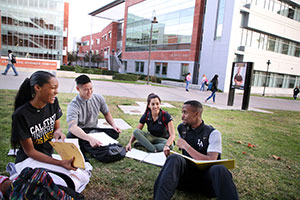
Summer Connections for Academic Excellence
California State University, Los Angeles
CSU Los Angeles's Summer Connections program—created through a collaboration between teaching and learning, tutoring, and advising—was designed to provide more than 4,000 incoming or transferring students with a remote Canvas Shell for accessing vital academic resources and engaging in discussions with other students in preparation for the fall 2020 term. Initially intended as a short-term COVID-19 solution, the program has been so successful that plans are already in place to continue offering this program in the future as a way of improving students' academic readiness.
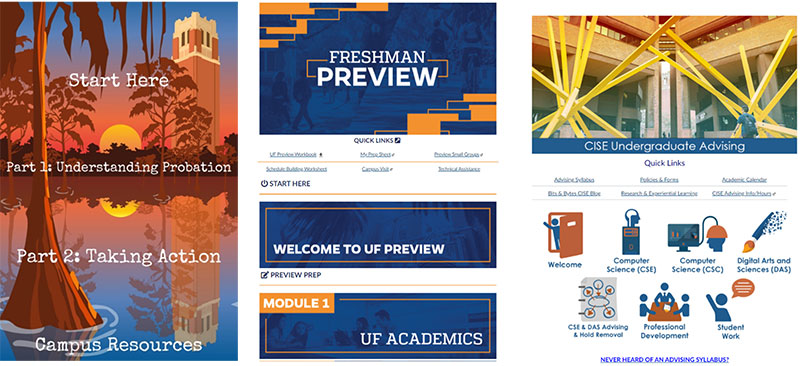
Leveraging the LMS to Flip Advising
University of Florida
University of Florida's Leveraging the LMS to Flip Advising program was created in response to the perceived need for a balanced asynchronous/synchronous advising experience for the student, as well as the need to apply instructional design concepts to the work of academic advising. Through existing technologies such as the LMS and a new Advisor Self-Service training course, advisors have learned to leverage instructional design to increase student preparedness, ownership, and decision-making through a backward-designed, or flipped, advising process.

AI: Authentic Interaction
California State University, Channel Islands
CSU Channel Islands's new chatbot project, Ekhobot, was originally intended to improve course engagement and retention rates for a specific segment of the CSUCI student body, but the COVID-19 pandemic has broadened the project's focus to include all CSUCI students. With a knowledge base of more than 1,000 understandings, Ekhobot is capable of responding to and providing assistance for a wide range of student inquiries. The system is also programmed with important messages and information to be proactively sent to students: key dates and deadlines, information on academic support and student wellbeing resources, nudges on actions for the student to take, and "fun interactions" to help keep students engaged.
Success Is Relative
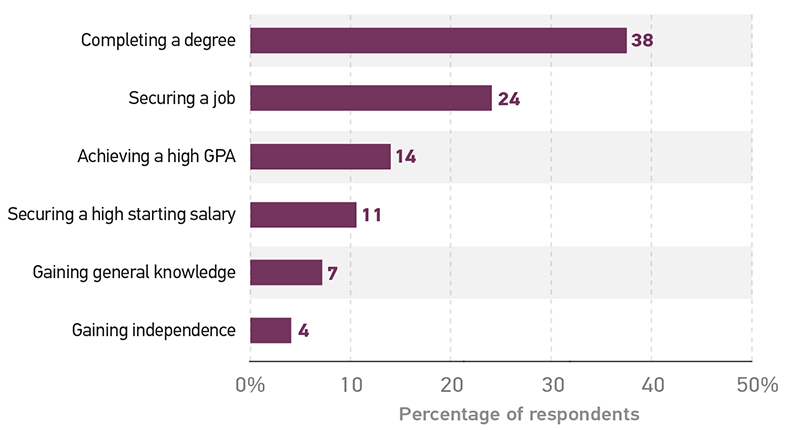
The primary measure of a successful undergraduate experience for students is completing a degree, but it is not the only one. Earning the sheepskin is more valued by community college (CC) students than non-CC students and by women more than men. Securing a job and achieving a high GPA are also important markers of success for undergraduate students, but these vary by year in school: the closer a student gets to graduation, the more important a job becomes and the less important a high GPA is. Many student success initiatives rely on heavily traditional institutional metrics such as retention, persistence, and graduation rates that can be very difficult to improve. Institutions would be well-served to (1) incorporate better, more specific measures of success that are student-centered and can better account for the variation in student goals, and (2) communicate clearly the links between the institutionally important metrics (e.g., retention, persistence, graduation) and metrics important to students (e.g., securing a job and high starting salary, achieving a high GPA).
Students Feel the Support
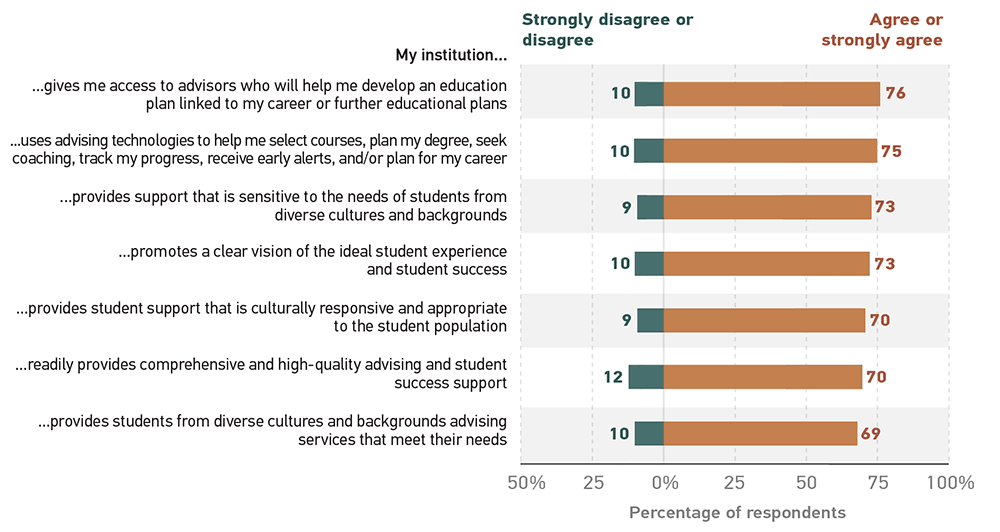
Undergraduate students overwhelmingly feel supported by their institutions. Between two-thirds and three-quarters of students told us that they feel supported by their institutions in terms of advising, the student experience, and diversity and culture issues. Students enrolled at CCs and smaller institutions tend to feel more supported than students at non-CC or larger institutions, respectively. However, Black/African American students tend to feel less supported by their institutions than students of other races/ethnicities.
Schrödinger's Student Success Tools
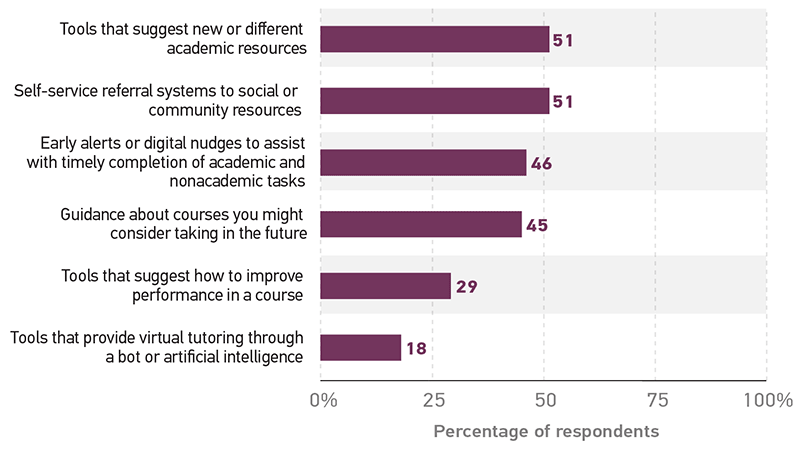
Students don't really know whether online student success tools are available to them. The majority of students said that to the best of their knowledge, tools that provide information about academic and community resources are provided by their institution. And nearly half of students said that early alerts and course recommendation tools are available to them. Whether an institution has adopted and deployed a student success tool for student use is an empirical question—it either has or it has not. However, when we look at the responses of students from the same institution as to whether they are provided tools for academic resources, community resources, early alerts, or guidance, we find considerable disagreement; roughly half said they have these tools provided to them, and half said they don't. That students don't know for certain what tools are available to them presents a challenge and an opportunity for institutions to raise awareness of the availability and location of these tools.
More Carrots, Please
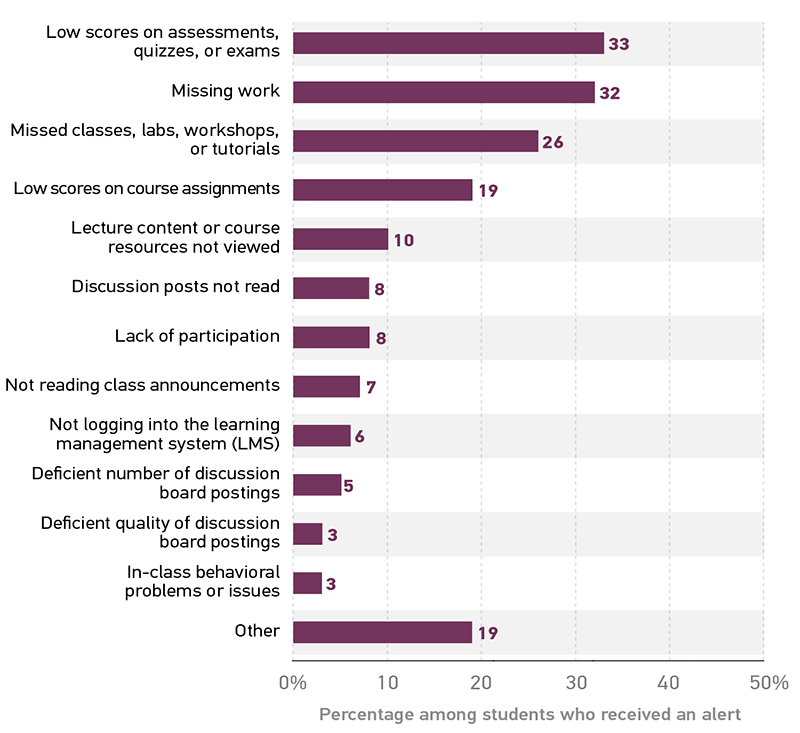
Course-related alerts and nudges overwhelmingly focus on the negative. Among the 19% of students who received an alert or nudge in the past year, notices about low scores on assignments, quizzes, or exams, missing work, and missed classes and labs are the types most frequently reported. Less-frequent nudges and alerts called students out for not reading or viewing course materials and assignments, for exhibiting undesirable behaviors (e.g., not participating, failing to log in, or engaging in behavioral problems in class), and for not contributing substantively to class discussions. About one in five respondents said that they had received some other type of alert or nudge, a close inspection of which reveals that in addition to notes about threats to their GPAs, students did receive some positive notifications in the form of kudos and congratulations for earning good grades, performing well on assignments, getting on the dean's list, or receiving some other award or recognition. In general terms, early-alert systems are designed to identify students who are at risk of not succeeding academically, so it isn't surprising that most nudges serve as "sticks." But if alerts and nudges are to change student behavior for the better, perhaps a few more "carrots" are needed, given that primarily negative messaging about students' shortcomings can be demoralizing and/or discouraging, producing outcomes opposite of those intended.1 Moreover, when alerts do focus on warnings to students about possible shortcomings in their academic work, institutions should be sure to offer specific actions and resources to help students get back on track.
Stimulus and Response
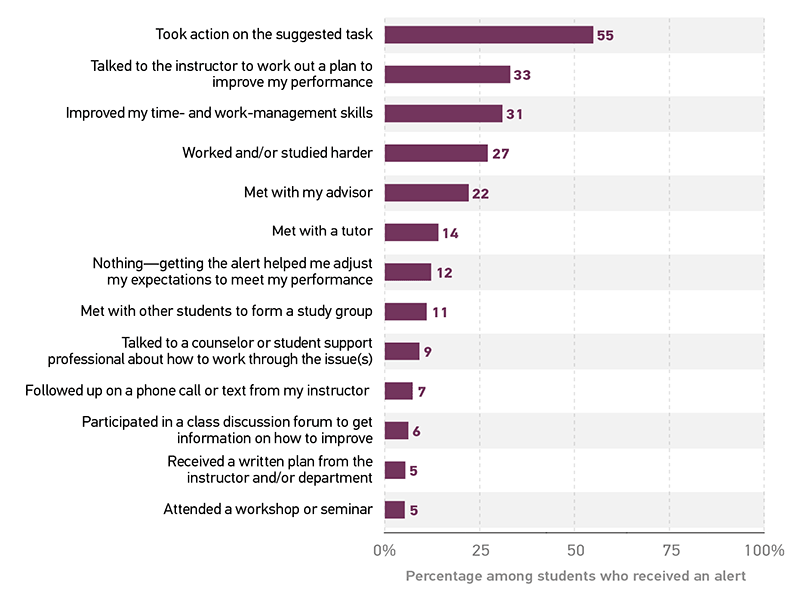
Students who receive alerts or nudges act on them. About half of students who received such a notification sought help and advice from their instructors, advisors, and/or tutors, and nearly half of students reported taking independent actions such as improving their time- and work-management skills, working and/or studying harder, and/or forming study groups with other students. Some evidence suggests that nudges are ineffective alone in producing changes in behavior that lead to improvements in academic outcomes; it appears that students either do not sustain the improved study behavior long enough to have an impact on their grades or they adjust their expectations about their performance to settle for their current grade.2 This suggests that in addition to the alerts and nudges students receive, a more robust program of academic support for altering study behavior is needed to realize the full potential of these tools.
Alerts and Nudges: Useful Unless They Aren't

Alerts and nudges are useful. The majority of students who received early alerts and nudges found them to be very or extremely useful, and nearly all (92%) thought they were at least moderately so. But some students—including CC students, first-generation students, Pell-eligible students, independent students with dependents, Black/African American students, and Hispanic/Latinx students—found nudges and alerts more useful than other students found them. Students who rated alerts and nudges not very useful or not at all useful did so because (1) they were already aware of the situation and did not need to be reminded, finding the alert or nudge to be off-putting, and/or (2) there was a lack of institutional support to help them act on the warning or advice.
Notes
-
Philip Oreopoulos and Uros Petronijevic, "The Remarkable Unresponsiveness of College Students to Nudging and What We Can Learn from It," NBER Working Working Paper 26059, July 2019.
↩︎ -
Ibid.
↩︎